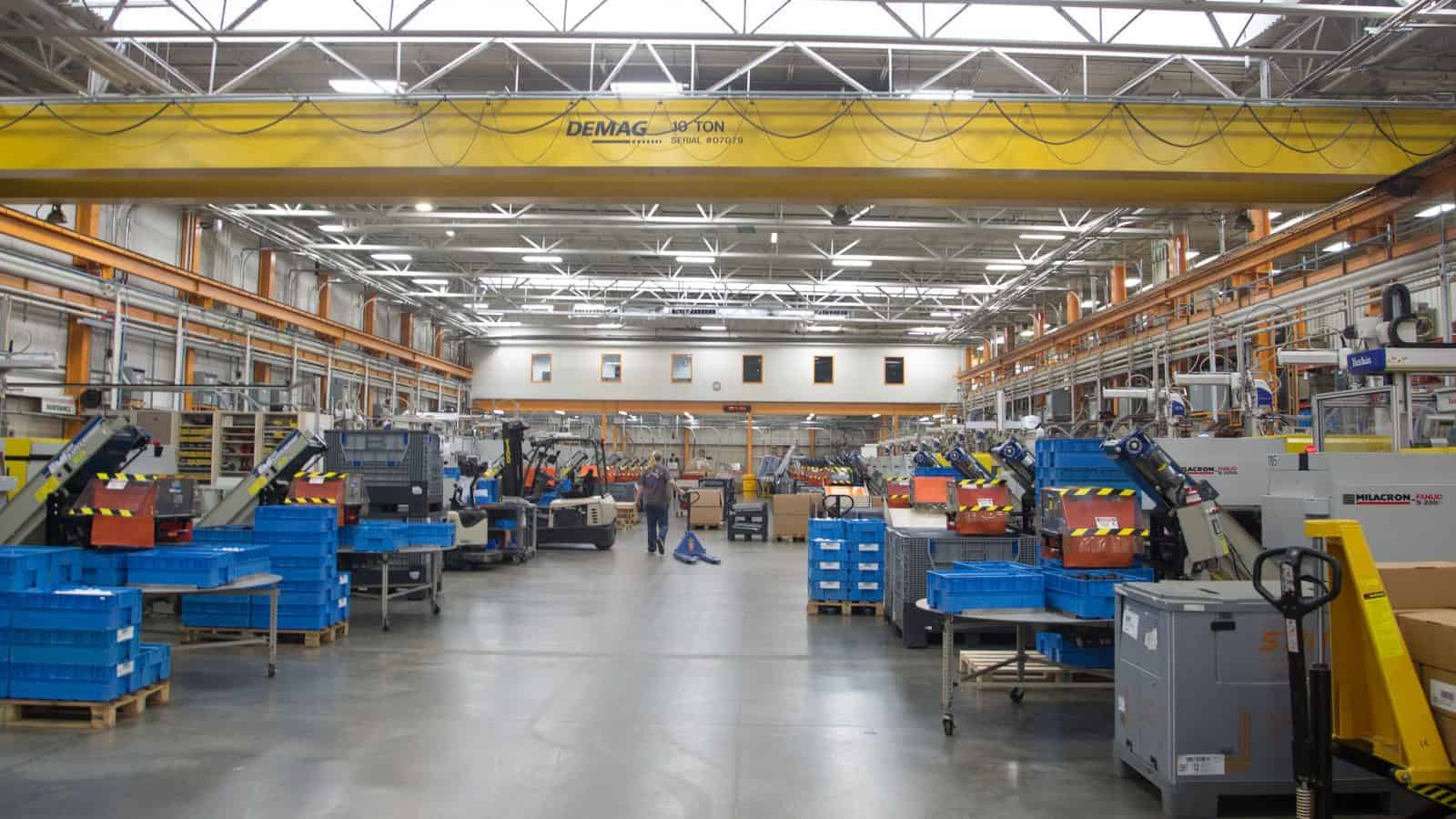Arizona: Manufacturing’s Crossroads
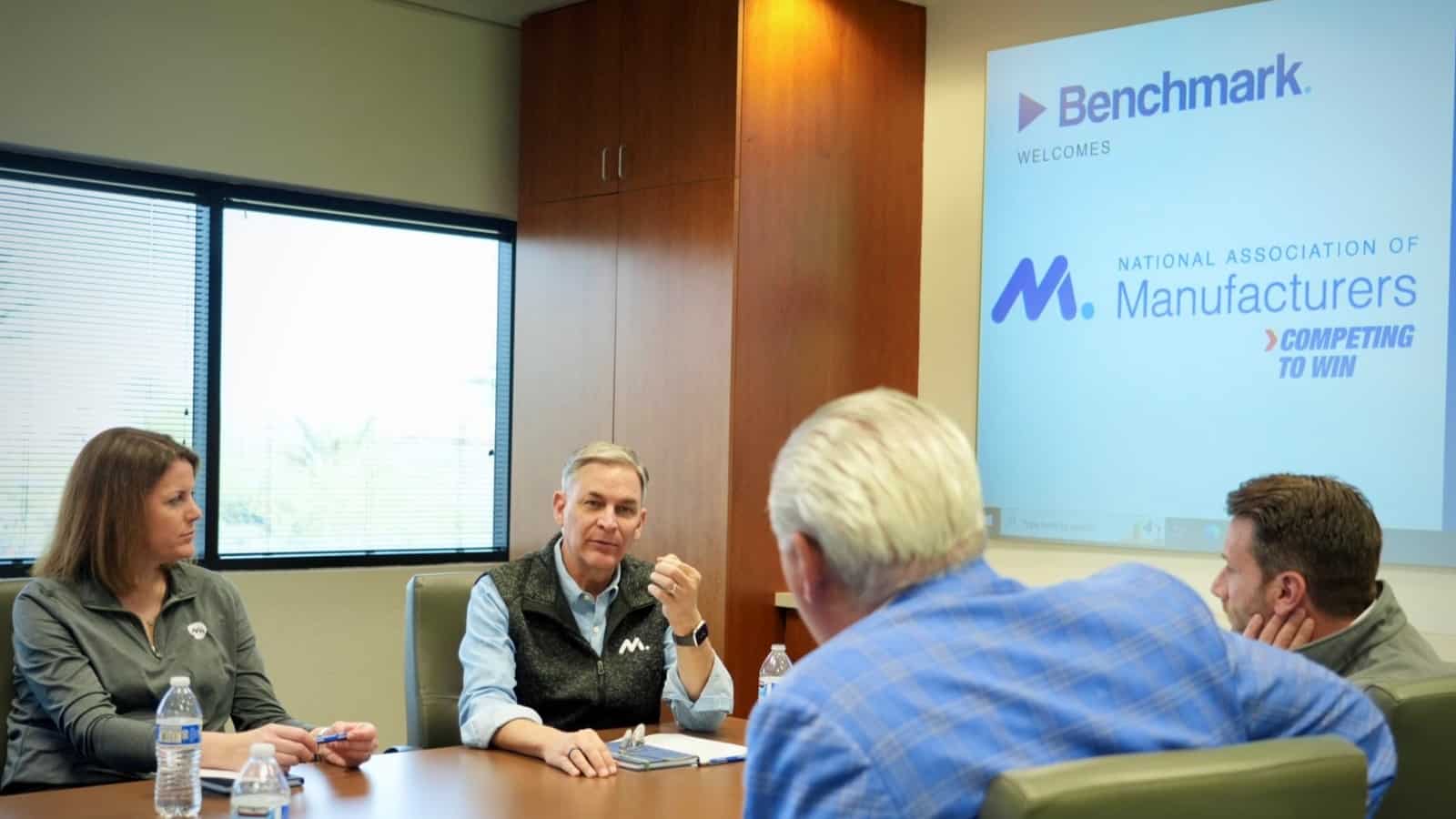
In the heat of Arizona’s “Silicon Desert” and surrounding communities, the future of America’s global competitiveness and climate goals aren’t just being forged—they also hang in the balance.
Last week for the first time in 2024, the NAM brought its Competing to Win Tour to Arizona, and that stark contrast between the status quo and the probable future was on display in Phoenix at global semiconductor equipment manufacturer Benchmark and small manufacturer Valley Forge & Bolt and at Resolution Copper in Superior.
- NAM President and CEO Jay Timmons, Manufacturing Institute President and Executive Director Carolyn Lee—who leads the NAM’s 501(c)3 workforce development and education affiliate—and Arizona Chamber of Commerce & Industry President and CEO Danny Seiden met with local manufacturers to gain their perspective and insights.
Why it matters: The Biden administration and Congress have secured key measures to bolster manufacturing in the U.S., including the NAM-championed CHIPS and Science Act and tax credits in the Inflation Reduction Act to manufacturers investing in advanced production and energy projects. But raw material, workforce and tax and regulatory policy challenges threaten to undermine policy aspirations.
Silicon Desert expansion: With the CHIPS and Science Act poised to transform the sector, Benchmark President and CEO Jeff Benck and Executive Vice President and Chief Operating Officer Dave Valkanoff led the tour of their state-of-the-art Phoenix facility.
- In a good spot: Benchmark is well-positioned for the coming growth in semiconductor equipment demand. It is focused on securing its workforce and navigating a complex regulatory landscape to maximize the opportunity.
- Workforce woes: Even with the NAM and the MI’s Benchmark-supported Creators Wanted campaign boosting the industry’s image and the MI’s FAME initiative training thousands of technicians, finding skilled labor remains the top challenge. Benchmark advances earn-and-learn programs and partnerships with Arizona State University and community colleges to help fill the pipeline, actions that, according to Lee, “can help change the game.”
- Red tape delays: Regulatory hurdles pose obstacles. Benchmark seeks streamlined permitting and sensible rules to maintain their global edge.
- Bullish outlook: Benck is optimistic about the future of U.S. manufacturing and semiconductor demand. Investments in people and technology position the company well to deliver the next generation of innovation.
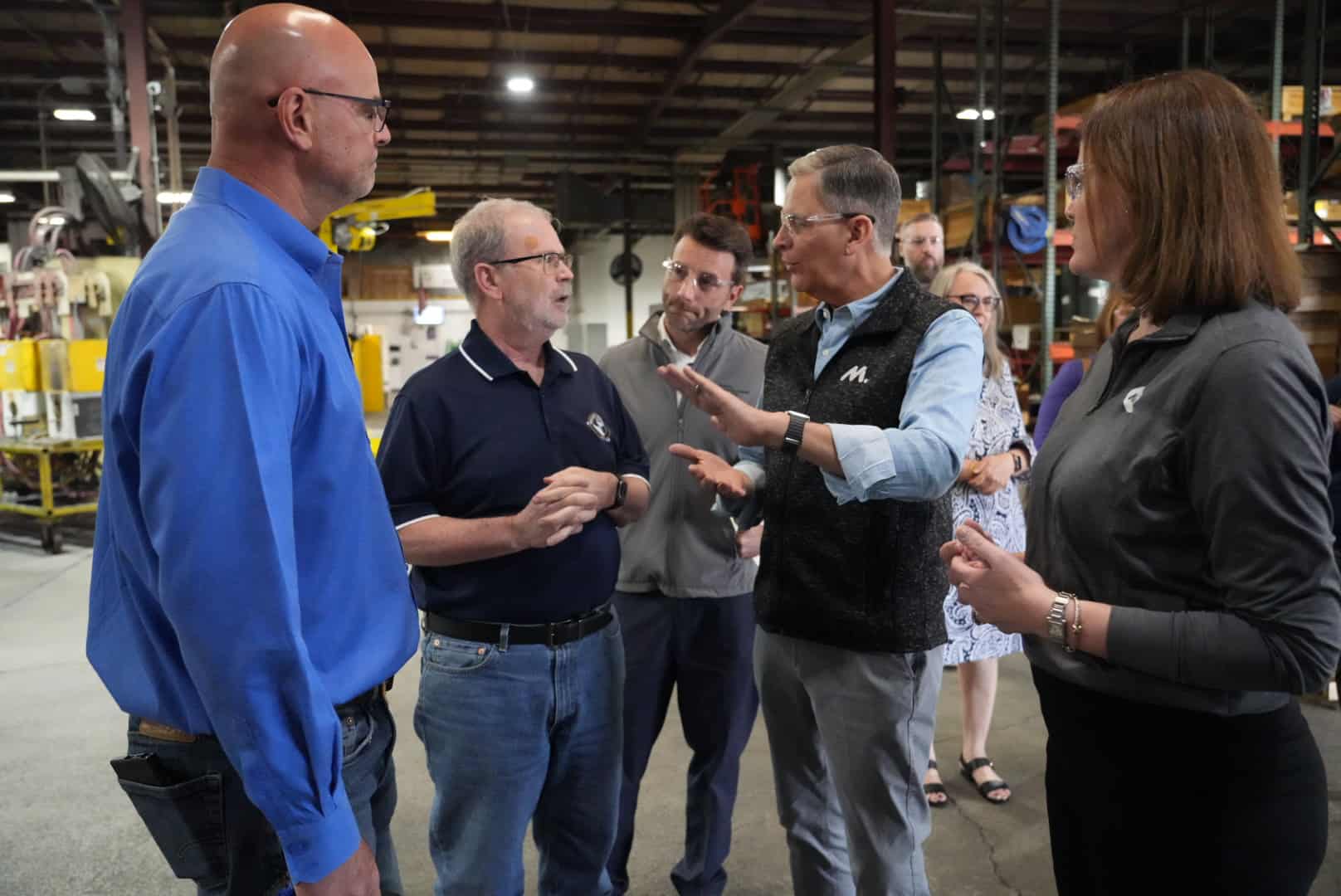
Taxes and immigration: The NAM’s return visit to Valley Forge & Bolt, after a stop last year with Sen. Kyrsten Sinema (I-AZ), shone a spotlight on the real-world impact of stalled tax policy and the urgent need for reform.
- Valley Forge & Bolt saw record sales in 2023 thanks to 2017 tax reforms boosting its equipment upgrades. Now, with provisions like full capital investment expensing stalled in Congress, orders have slowed.
- CEO Michele Clarke and COO Bret Halley made the case for R&D expensing, interest deductibility and a return to full capital investment expensing. Without these, they said, job growth and America’s manufacturing competitive edge are at risk.
- Skilled workers needed: Despite its success, Valley Forge says finding skilled workers is a constant struggle. Immigration reform is a must to secure the right talent pipeline, said Clarke. “Did you notice our engineers? Most of them are under 30 because we’re snatching them right out of college,” added Clarke. “The engineering talent in this country is dwindling, and we’re not authorizing enough green cards. I, myself, was a green card holder before I became a citizen.”

Policy roadblocks: The NAM’s visit to Rio Tinto’s Resolution Copper site highlighted the urgency of permitting reform in the face of critical mineral needs.
- Copper’s critical role: Copper is essential for clean energy. Electric vehicles, solar power grids and wind turbines all demand huge quantities. Yet, the U.S. remains heavily reliant on imported copper, jeopardizing progress.
- Massive potential: The domestic solution lies within the stalled Resolution Copper mine. With its potential to supply 25% of U.S. copper demand, it’s poised to be a key piece of the puzzle.
- Project in limbo: Despite a 350-strong workforce modernizing and maintaining the mine, permitting delays stifle the project’s full impact.
- Sustainable practices: “Resolution Copper is the future of eco-conscious mining,” said NAM Managing Vice President of Brand Strategy Chrys Kefalas, who toured the site. “Their team innovates sustainable practices, leads in water conservation and even supplies 7 billion gallons of water to Arizona farms. And what is more, it isn’t just the facts of the matter or what you saw that drives this point home, but the people who have worked on the site for years make all that clear with the pride they have about the project and their determination to see Resolution Copper through to making lives better for everyone.”
- Jobs and growth: Led by President and General Manager Vicky Peacey, the project promises to contribute $1 billion annually to the economy and more than 1,500 Arizona jobs. “This is about people, jobs and supply chains; and it’s also about realizing clean energy ambitions at the speed and scale that climate goals demand,” said Kefalas.
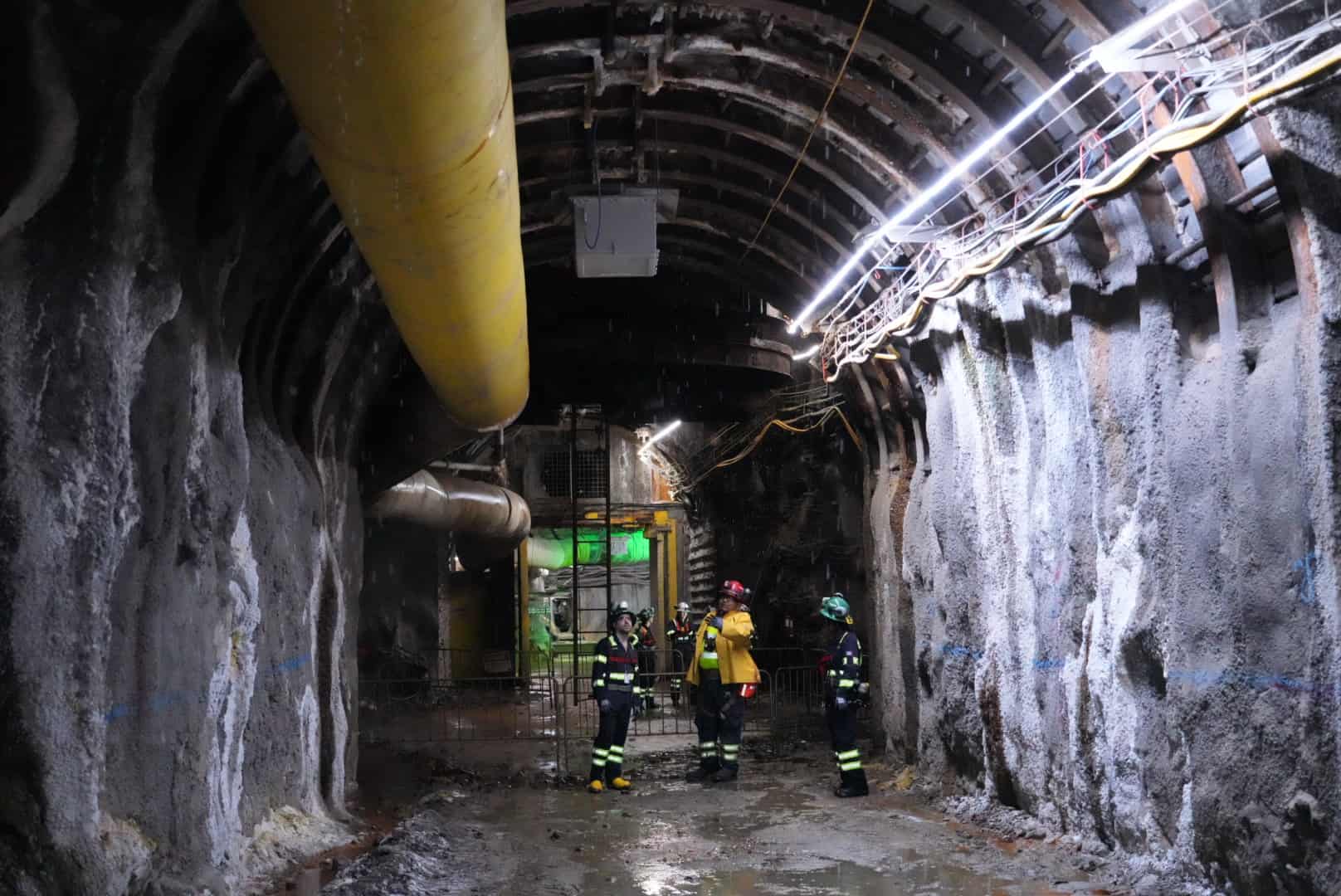
The bottom line: “The future of U.S. manufacturing might hinge on these contrasting stories. Are we a nation that champions innovation, attracts and keeps the brightest here, supports our manufacturers and tackles climate goals with homegrown solutions, or one that stalls progress in its own backyard,” said Timmons.
- “Arizona is at the epicenter of American manufacturing’s next chapter, and with smart policies and fewer unforced errors at the federal level, we can clear the runway for growth,” added Seiden.
Manufacturing Leaders: Congress Must Act Now

It’s imperative for the strength of not only manufacturing in the U.S. but democracy worldwide that Congress move now to advance a security package and government funding, said NAM President and CEO Jay Timmons, Johnson & Johnson Executive Vice President and Chief Technical Operations & Risk Officer and NAM Board Chair Kathy Wengel and Rockwell Automation Chairman and CEO and NAM Board Vice Chair Blake Moret on Monday.
What’s going on: “For the strength of our democracy here at home and the protection of democracy around the world, manufacturers are calling on Congress and President Biden to act swiftly to keep the government open, pass pro-growth tax provisions, secure our border and approve urgently needed aid for Ukraine,” the three manufacturing leaders told Congress ahead of Biden’s meeting with congressional leaders.
Why it’s important: In March 2022, shortly after Russia’s invasion of Ukraine, the NAM Board passed a unanimous resolution condemning the act and expressing solidarity with the Ukrainian people in their fight for independence.
- In February 2023, Ukrainian President Volodymyr Zelenskyy spoke to the NAM Board in a speech to the American business community. “We will prove that democracy is stronger than tyranny,” Zelenskyy said in that address. “When Russia loses, we will prove that terrorist states cannot overcome the power of a united democratic world.”
What should be done: Timmons, Wengel and Moret hammered home the criticality of swift action by Congress.
- “With time running short, manufacturers are looking to our leaders to act. They can address all of these priorities. In fact, they must address them all—for the future of our industry, the security of our country and the defense of democracy.”
NAM-Supported PBM Bill Clears House Oversight Committee

Pharmacy benefit managers are contributing to the skyrocketing cost of health care for manufacturers and must be reined in—and that’s why the NAM supports the bipartisan Delinking Revenue from Unfair Gouging (DRUG) Act, passed yesterday by the House Oversight and Accountability Committee.
What’s going on: PBMs, created in the 1960s with the intention of keeping prescription drugs affordable, are now doing the very opposite, the NAM informed the committee ahead of Tuesday’s markup.
- PBMs “increas[e] the price that health plan participants pay for medicines,” NAM Vice President of Domestic Policy Charles Crain said. “By applying upward pressure to list prices that dictate what patients pay at the pharmacy counter, pocketing manufacturer rebates and failing to provide an appropriate level of transparency about their business models, PBMs increase health care costs at the expense of manufacturers and manufacturing workers.”
- In addition to other reforms, the DRUG Act would require “delinking”—ensuring that PBMs charge a flat rate for their services rather than charging a percentage of a medication’s list price. This critical reform would “remov[e] PBMs’ incentive to put upward pressure on list prices in order to maximize their own profits,” Crain said.
Why it’s important: The NAM—whose advocacy, including a six-figure ad campaign, helped lead the DRUG Act to passage by the House Oversight Committee—“has long favored delinking PBM compensation from the list price of medications, including in the commercial market,” Crain continued.
- The NAM will continue to advocate for PBM reforms that “will benefit employers by making PBM contracts more straightforward, transparent and predictable—and will benefit workers by reducing the prices they pay out of pocket for their prescriptions.”
NAM to Congress: SEC Must Fix Flawed Climate-Reporting Rule
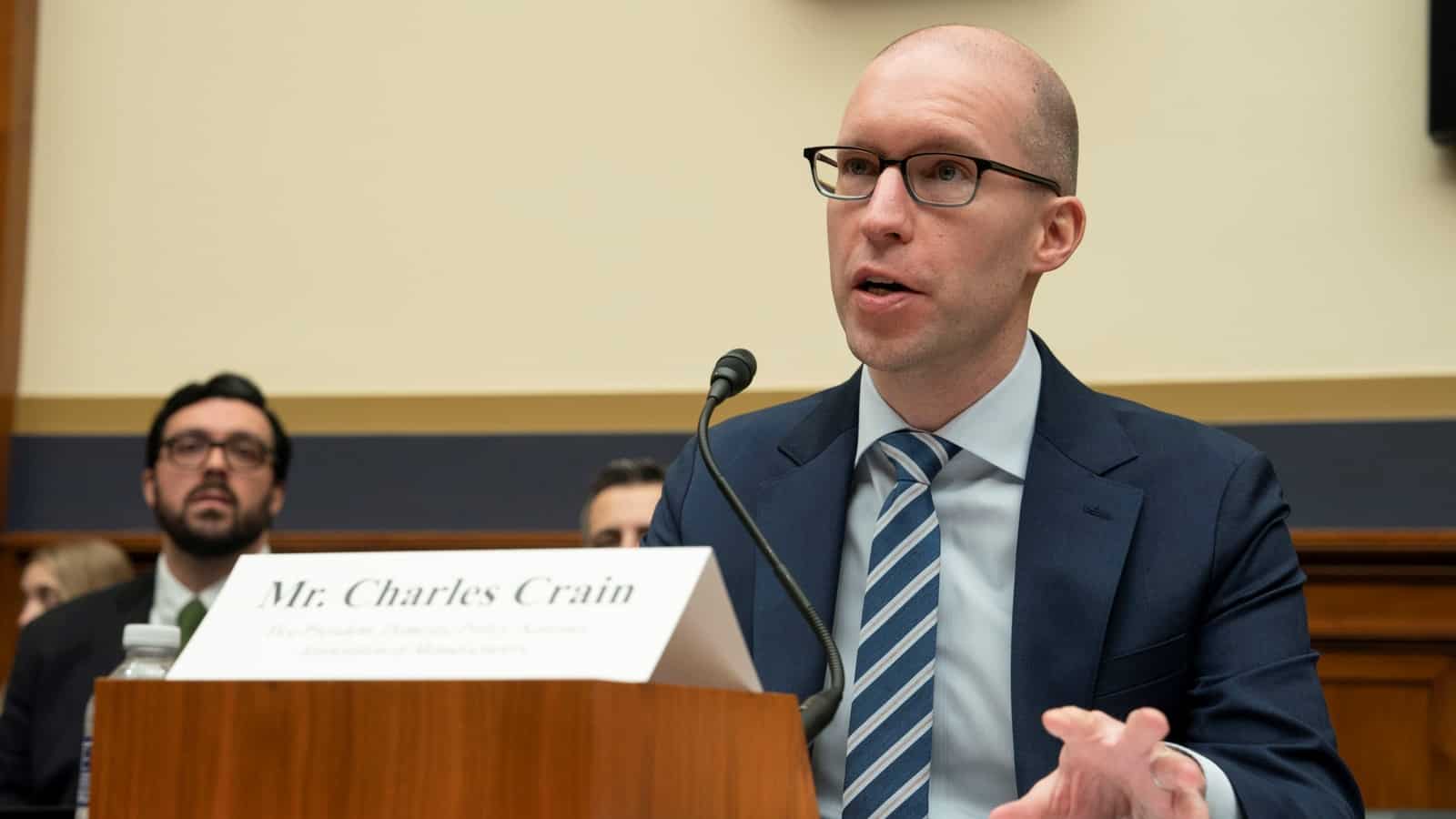
The Securities and Exchange Commission’s pending climate disclosure rule would place an enormous, untenable burden on manufacturers—and impose a disproportionate hardship on small businesses, NAM Vice President of Domestic Policy Charles Crain told lawmakers Thursday.
What’s going on: Crain gave testimony before the House Financial Services Subcommittee on Oversight and Investigations on the damaging effects of the SEC’s proposed climate rule, which would require businesses to reveal large amounts of convoluted (and often sensitive) climate-related data.
- The plan would force disclosure of so-called “Scope 3” emissions—those that come from companies’ supply chains—and institute new climate-related accounting requirements, among other mandates.
Why it’s a problem: If finalized, the rule would divert funds from manufacturing growth, including at small manufacturers.
- “Manufacturing pioneers groundbreaking technologies, including the innovations necessary to combat climate change,” Crain said. “The rule would impose tremendous costs on manufacturers of all sizes—while overwhelming investors with immaterial information. And the SEC hasn’t done the work to show that the rule’s benefits outweigh its costs, or that the rule is even within the SEC’s legal authority.”
- The proposed regulation would, by the agency’s own accounting, “raise the cost to businesses of complying with its overall disclosure rules to $10.2 billion from $3.9 billion, an additional cost of about $530,000 a year for a bigger business,” according to The Wall Street Journal (subscription).
Costs to manufacturers: Crain told lawmakers that the SEC’s analysis likely understates the true costs of the rule, in part because the agency did not consider the impacts on private businesses.
- “For the larger companies subject to [the Scope 3] requirement, the SEC has admitted that it cannot ‘fully and accurately quantify’ the costs,” Crain said. “But for the small businesses that are swept into large companies’ Scope 3 efforts, the SEC hasn’t even tried. The SEC’s proposal does not include any discussion of the Scope 3 costs that will fall on small and private businesses.”
- Crain warned lawmakers that these compliance costs would represent a “huge resource diversion” for small manufacturers.
Regulatory onslaught: Crain shared the NAM’s landmark Cost of Federal Regulations study with lawmakers, explaining that the SEC’s proposal would add to the $50,000-per-employee-per-year regulatory burden small manufacturers face.
- “The SEC’s climate rule is at the center of this regulatory onslaught,” Crain said.
NAM in the news: Bloomberg (subscription), Law360 and Pensions & Investments all covered the NAM’s testimony.
House Passes Bill That Would Rein in PBMs

The House passed a health care package on Monday that includes measures to curb some practices by pharmacy benefit managers, according to STAT News.
What’s going on: The Lower Costs, More Transparency Leadership Act, which passed on a bipartisan vote, “would equalize payment between hospital outpatient departments and doctors’ offices for administering medicines in Medicare, rein in some practices by pharmacy benefit managers and codify health care price transparency rules.”
- The vote on the measure was scheduled for September originally but was pushed back amid a larger funding dispute.
What it means: The package would prohibit PBMs from “spread pricing”—or charging Medicaid more than they pay pharmacies for medications.
- It would also require PBMs, “clinical lab test providers, imaging providers [and] ambulatory surgical centers … to be more transparent about their pricing.”
What’s next: “Some community health advocates hope Monday’s vote will jump-start negotiations with the Senate, where leaders have signaled they’re looking for more than what’s in the House bill,” POLITICO reports.
Our view: “House passage of the Lower Costs, More Transparency Act is a step forward for PBM transparency, but Congress must continue to advance reforms that ensure PBMs pass on prescription drug discounts directly to plan sponsors and patients as well as delink their compensation from the list price of drugs,” the NAM said on Tuesday.
Right-to-Repair Laws Harm Manufacturers and Consumers

So-called “right-to-repair” policies undo many of the federal and state laws designed to protect consumers and manufacturers—and they could result in “steep cost[s] to quality, performance, consumer safety, the environment and the broader U.S. economy,” according to a new NAM-commissioned study.
What’s going on: “The Economic Downsides of ‘Right-to-Repair,’” by Capital Policy Analytics’ Ike Brannon and Kerri Seyfert, finds that enacting right-to-repair laws could disrupt supply chains, leave manufacturers open to intellectual property theft, drive up costs for consumers and manufacturers and increase greenhouse emissions in the atmosphere.
- Right-to-repair policies, currently in place in more than 30 states, generally require manufacturers to make all tools, guides and parts required to repair their devices available to everyone, including independent repair outfits.
- A federal right-to-repair law “would ultimately alter how manufacturers operate their businesses, and there is no guarantee that consumers would benefit, as manufacturers would be forced to change the way their products perform,” according to the study.
Why it’s important: “There is a wide range of unintended and potentially harmful consequences that would arise if the most commonly introduced versions of ‘right-to-repair’ go into effect,” Brannon and Seyfert write.
- In addition to making product repair more difficult, such policies could drastically increase compliance costs for manufacturers and drive up prices for consumers.
Reform PBMs, NAM Tells Congress

Pharmacy benefit managers—companies that were first established to manage the cost of prescription drugs—are now driving up pharmaceutical prices for employers and patients, the NAM told the House Committee on Energy and Commerce this week.
What’s going on: While manufacturers remain committed to providing health benefits to their workers, PBMs are “[c]ontributing to the increasing costs of health care,” said NAM Vice President of Policy Chris Netram on Monday, ahead of the committee’s markup of 44 pieces of legislation.
- These measures included the Protecting Patients Against PBM Abuses Act and the Medicare PBM Accountability Act.
Why it’s important: PBMs operate with a virtual monopoly, as just a few of them now control up to 89% of the prescription drug market, Netram continued.
- PBMs operate with limited federal oversight and frequently steer business toward pharmacy networks owned by their parent firms.
What should be done: Congress should pass legislation aimed at changing the PBM model.
- “The complex formulas and opaque business practices of PBMs must come to an end,” the NAM wrote in a social post Tuesday. “Congress must address PBM reform to increase transparency, ensure pharmaceutical savings are passed to the plan sponsor and patients and delink PBM compensation from the list price of drugs.”
In related news: CVS Health “will move away from the complex formulas used to set the prices of the prescription drugs it sells, shifting to a simpler model that could upend how American pharmacies are paid,” The Wall Street Journal (subscription) reports.
NAM Fights Restrictive Power Plant Rule

The Environmental Protection Agency is considering a rule that would change the way power plants operate in America—but without significant adjustments, it could have devastating consequences.
The background: Right now, about 60% of America’s power generation comes from a combination of coal and natural gas.
- The EPA’s proposed rule would require coal and natural gas–fired power plants to deploy either carbon capture technology or hydrogen power within 10 years to lower emissions.
- If unable to deploy these technologies at the scale required in that timeframe, these power plants would be forced to shut down.
The problem: While carbon capture and hydrogen power technologies are vital to decarbonization, the required scale and timeline make implementing this rule difficult.
- “Carbon capture and hydrogen are tremendously promising—and manufacturers are leading the way in developing these technologies. But neither have been deployed at the scale needed to support 60% of our entire power generation within a short timeframe,” said NAM Vice President of Domestic Policy Brandon Farris.
The timeline: The EPA’s proposed 10-year timeline leaves little room for flexibility when it comes to implementing the order. According to Farris, environmental impact studies alone could take more than four years.
- “We’re talking about 10 years to essentially retrofit more than half of our power generation,” said Farris. “You would need this permitted, installed and operational within those 10 years, which would be difficult even if the technology was available today at scale.”
The impact: The rule would require plants that do not meet the new standard in 10 years to shut down entirely. As a result, many plants would have to shift resources immediately to plan for a likely shutdown.
- “The big hammer is these plants having to shut down in 10 years if these technologies are not installed,” said Farris.
- “So you’ll see a lot of money spent and not a lot of progress made because this technology isn’t ready at scale, and we have only a few years to permit, install and operate.”
The next steps: The NAM has submitted comments on the rule, and the EPA is working on a final version now.
- “We’ve emphasized that the timeline is not workable,” said Farris. “You would need to have a longer off-ramp and a way to ensure that the technologies required are proven at scale.”
SEC Reverses Course After NAM Legal Challenge

The NAM secured a critical win Monday when the Securities and Exchange Commission issued an order reversing course on a novel rule interpretation that would have forced private companies to disclose proprietary financial information publicly, Law 360 (subscription) reports.
What’s going on: In 2021, the SEC adopted a novel reinterpretation of SEC Rule 15c2-11, imposing the rule’s public disclosure requirements on private companies that raise capital via corporate bond issuances under SEC Rule 144A—without giving manufacturers the opportunity to provide comment on the damaging impacts of such a consequential change.
- The NAM and the Kentucky Association of Manufacturers pursued multipronged litigation and advocacy efforts arguing to the Commission and to the courts that the SEC’s actions were both procedurally improper and substantively indefensible.
- Rule 15c2-11 requires public disclosures for the protection of everyday investors in publicly traded companies that issue so-called “penny stocks.”
- But in 2020, the SEC expanded the rule to apply to privately held companies issuing corporate bonds to large institutional investors under Rule 144A.
- For decades prior, Rule 144A permitted trades in private companies’ fixed-incomes securities without public disclosure of the issuers’ financial information. Indeed, the SEC’s entire purpose for adopting Rule 144A was to allow companies to access the debt markets without public disclosure of their financial and business-strategy information.
NAM in the news: The SEC took the rare step of reversing its position on Monday, declaring that “it is appropriate in the public interest and consistent with the protection of investors” to exempt Rule 144A fixed-income securities from the requirements of Rule 15c2-11.
- “The order comes after industry groups petitioned the agency to provide relief to certain corporate debt issuers. The National Association of Manufacturers and the Kentucky Association of Manufacturers, which sought such relief in November 2022, also sued the agency in September, arguing that the SEC’s policy was enacted without public input and could harm job-creation efforts, given how many private companies rely on 144A bonds,” Law360 reports.
- Bloomberg Tax (subscription) also covered the news.
Why it’s important: Expansion of Rule 15c2-11 would have meant higher borrowing costs and less liquidity in the market—and resulted in more than 100,000 job losses a year, according to recent EY analysis prepared on behalf of the NAM.
Our take: The SEC’s action not only restores private companies’ ability to access the debt markets, but also exemplifies why the NAM litigates—as a last line of defense, to force an agency’s hand.
- “This order from the SEC is a landmark victory for manufacturers and a powerful affirmation of the NAM Legal Center’s ability to rein in regulatory overreach,” NAM Chief Legal Officer Linda Kelly said Tuesday. “We are thrilled that the Commission has reversed course on this unlawful attempt to impose a novel, onerous and wholly unjustified regulatory mandate on private companies.”
- Added KAM President and CEO Frank Jemley: “We applaud the SEC’s decision to withdraw its ill-conceived proposal. American business and free enterprise are best served when government respects the boundaries of its authority, which the SEC clearly did not do in this matter.”
New Regulations Could Hurt Competitiveness
Oppose Harmful Regulations
Take action
The NAM is leading the charge in urging the Biden administration to walk back a proposed revision to the National Ambient Air Quality Standards for fine particulate matter (PM2.5).
With the release of a letter signed by more than 70 associations representing nearly every sector of the U.S. economy and a new video advertisement, the NAM is highlighting how these regulatory actions would devastate the economy and actively undermine President Biden’s goal to expand manufacturing in the United States.
What’s going on: When the Environmental Protection Agency set forth the tentative new air quality standards earlier this year, manufacturers quickly recognized that if enacted, the new rules would put an undue burden on the industry—and could force companies to move operations overseas.
- Soon, manufacturers and related associations across the country began to speak out about the harm to their operations and communities, even as they affirmed the industry’s longstanding commitment to a clean, safe environment for all.
The background: The EPA’s proposed changes to the National Ambient Air Quality Standards—currently under review by the White House’s Office of Information and Regulatory Affairs— would lower the primary annual particulate matter standard from 12.0 µg/m3 to between 8.0 and 10.0 µg/m3.
- The EPA has estimated the total cost of the controls required for compliance with the proposed standard at up to $1.8 billion—and that figure could go higher, the agency admitted.
- What’s more, some areas in the U.S. are already in “nonattainment” with the current PM2.5 standard, so a stricter standard will only put them further away from compliance and economic growth.
The costs: According to an analysis by Oxford Analytics and commissioned by the NAM, the revisions would:
- Threaten nearly $200 billion of economic activity and put up to a million current jobs at risk, both directly from manufacturing and indirectly from supply chain spending;
- In addition, growth in restricted areas may be constrained, limiting investment and expansion over the coming years; if the PM2.5 standard moves to 8 from the current 12, nearly 40% of the country will live in nonattainment areas, putting jobs and livelihoods at risk as factories may no longer be able to operate if located in an area that is in nonattainment, and no new facilities can be built to grow economic prospects; and
- Hit California’s manufacturing sector hardest, followed by Michigan and Illinois.
Speaking out: Many manufacturers from all sectors, along with related associations, have made their concerns public.
- Michael Canty, president and CEO of Alloy Precision Technologies of Mentor, Ohio, pointed out that these regulations may force companies to move production to other countries that don’t care about emissions reductions, unlike the U.S.
- Mark Biel, CEO of the Chemical Industry Council of Illinois, also worries that this regulation could make his state less attractive for manufacturers, despite its many assets.
- Dawn Crandall, executive vice president of government relations for the Home Builders Association of Michigan, decried the potential knock-on effects for Michigan’s suffering housing market.
The last word: The proposed changes “would risk jobs and livelihoods by making it even more difficult to obtain permits for new factories, facilities and infrastructure to power economic growth,” leadership from approximately 70 industry groups told White House Chief of Staff Jeffrey Zients yesterday.
- The revisions “would also threaten successful implementation of the Infrastructure Investment and Jobs Act, the CHIPS and Science Act and the important clean energy provisions of the Inflation Reduction Act. … We urge you to ensure the EPA maintains the existing fine particulate matter standards to [safeguard] both continued environmental protection and economic growth.”
